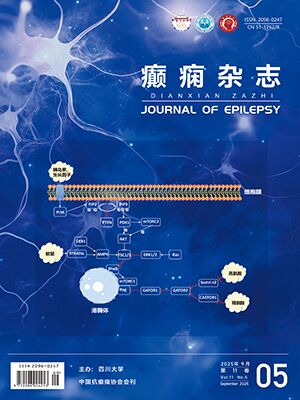| 1. |
World Health Organization. Epilepsy: a public health imperative. 2019.
|
| 2. |
Olusanya BO, Wright SM, Nair MKC, et al. Global Research on Developmental Disabilities Collaborators (GRDDC). Global burden of childhood epilepsy, intellectual disability, and sensory impairments. Pediatrics, 2020, 146(1): e20192623.
|
| 3. |
Song P, Liu Y, Yu X, et al. Prevalence of epilepsy in China between 1990 and 2015: a systematic review and meta-analysis. J Glob Health, 2017, 7(2): 020706.
|
| 4. |
肖小嫱. 中文版成人癫痫患者自我管理量表(C-ESMS)信效度检验及应. 西南医科大学, 硕士学位论文, 2019.
|
| 5. |
Tanya L Packer, America Fracini, Åsa Audulv, et al. What we know about the purpose, theoretical foundation, scope and dimensionality of existing self-management measurement tools: a scoping review. Patient Educ Couns, 2018, 101(4): 579-595.
|
| 6. |
Émilie Hudon, Catherine Hudon, Mireille Lambert, et al. Generic self-reported questionnaires measuring self-management: a scoping review. Clin Nurs Res, 2021, 30(6): 855-865.
|
| 7. |
Smith G, Modi AC, Johnson EK, et al. Measurement in pediatric epilepsy self-management: a critical review. Epilepsia, 2018, 59(3): 509-522.
|
| 8. |
Avani C Modi, Sally Monahan, Dee Daniels, et al. Development and validation of the pediatric epilepsy medication self-management questionnaire. Epilepsy Behav, 2010, 18(1-2): 94-9.
|
| 9. |
于桂玲, 王爱敏, 李莎, 等. 应用Delphi法构建4~11岁哮喘儿童家庭自我管理评价指标体系. 中国护理管理, 2013, 13(9): 39-42.
|
| 10. |
Kathleen J Sawin, Amy Heffelfinger, Susan E Cashin, et al. The development of the Adolescent/Young Adult Self-Management and Independence Scale II: Psychometric data. J Pediatr Rehabil Med, 2018, 11(4): 311-322.
|
| 11. |
康洪彬, 李艳君. 中文版改良服药信念量表在临床中的应用价值探讨. 中国卫生统计, 2021, 38(5): 766-768.
|
| 12. |
Megan Loew, Justin L Williams, Kathryn Russell, et al. The adolescent and caregiver sickle cell disease self-management skills checklist: preliminary reliability and validity. J Pediatr Hematol Oncol, 2020, 42(1): 12-19.
|
| 13. |
徐晶晶, 顾愹, 朱敏, 等. 中文版青少年糖尿病行为评定量表的跨文化调试及信度、效度检验研究. 中国糖尿病杂志, 2018, 26(6): 463-469.
|
| 14. |
Çağrı Çövener Özçelik, Eda Aktaş, Nesrin Şen Celasin, et al. The development and validation of a turkish insulin treatment self-management scale child form (ages 8-18) and parent form. J Clin Res Pediatr Endocrinol, 2019, 11(3): 278-286.
|
| 15. |
Jessica S Pierce, Sara S Jordan, Randolph C Arnau. Development and validation of the pediatric diabetes routines questionnaire for adolescents. J Clin Psychol Med Settings, 2019, 26(1): 47-58.
|
| 16. |
Morisky DE, DiMatteo MR. Improving the measurement of self reported medication nonadherence: response to authors. J Clin Epidemiol, 2011, 64(3): 255-257.
|
| 17. |
胡平, 张际, 黄英, 等. 哮喘儿童自我管理量表的编制. 中国全科医学, 2010, 13(31): 3513-3515.
|
| 18. |
杨春松, 张伶俐, 李佳圆, 等. 基于保护动机理论的儿童抽动障碍患者用药依从性研究. 中国药房, 2021, 32(19): 2415-2420.
|
| 19. |
B Bursch, L Schwankovsky, J Gilbert, et al. Construction and validation of four childhood asthma self-management scales: parent barriers, child and parent self-efficacy, and parent belief in treatment efficacy. J Asthma, 1999, 36(1): 115-128.
|
| 20. |
Escoffery C. Factor analyses of an adult epilepsy self-management measurement instrument (AESMMI). Epilepsy Behav, 2015, 50: 184-189.
|
| 21. |
Luedke MW, Blalock DV, Goldstein KM, et al. Self-management of epilepsy: a systematic review. Ann Intern Med. 2019, 171(2): 117-126.
|
| 22. |
Yang C, Hao Z, Yu D, et al. The prevalence rates of medication adherence and factors influencing adherence to antiepileptic drugs in children with epilepsy: a systematic review and meta analysis. Epilepsy Res, 2018, 142: 88-99.
|
| 23. |
Jing Wen Tan, Teik Beng Khoo, Nurul Farhana Burharudin, et al. Medication self-management among parents of children with epilepsy at a tertiary care center in Malaysia. Epilepsy Behav, 2020, 111: 107317.
|
| 24. |
张芷菡, 贲新宇, 栾超, 等. 癫痫患者健康管理模式应用的研究进展. 癫痫杂志, 2023, 9(5): 417-422.
|




